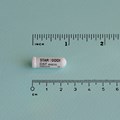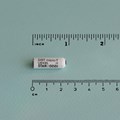DST nano-T
World's Smallest Waterproof Temperature Logger
Fits in tight spaces. Accuracy guaranteed with individually calibrated logger, with traceable calibration.
Measures temperature in small containers or vials in heat studies, cold chain and storage monitoring for quality control in pharmaceutical production and more.
Key features
- Small size - only 1.3 g, 17mm x 6mm
- Guaranteed accuracy for one year
- Traceability in cold chain monitoring and storage
Leakproof housing- Sensor holder for stable placement in vials and syringes available
- Description
Ultra small sizeThe DST nano-T is the world's smallest temperature data logger. This tiny logger weighs only 1.3 g and is 17mm long and 6mm wide.
Applications
DST temperature loggers are used in any environment where accurate, traceable measurements are required such as in:
- Cold chain monitoring
- Regulatory compliance and quality control
- Storage monitoring
- Logistics monitoring
Guaranteed accuracy and performance
All loggers are delivered with calibration certificates. Each logger is calibrated to specifications using test equipment traceable to the International System of Units (SI), through a National Metrological Institute (Netherlands: RvA K013). The accuracy and performance of the logger are guaranteed for
one year post delivery.Traceability in cold chain monitoring and storage
Every measurement has a timestamp as the logger synchronizes its internal clock with the date and time on the computer being used. Each logger has an electronic serial number as well as an external serial number on the housing for identification and traceability.
Leak-proof housing
The logger is hermetically sealed in a leak-proof housing made of carefully chosen biocompatible ceramic material.
Sensor holder for stable placement in vials and syringes available
A sensor holder, made of stainless steel, keeps the logger in an optimal centered position inside vials and syringes throughout the production and shipping process.
The sensor holder guarantees a stable placement for temperature measurements. This allows users to easily identify any unexpected temperature changes in the production process, storage, shipping, or breaks in the cold chain.





.jpg?w=120&h=120&mode=crop)

